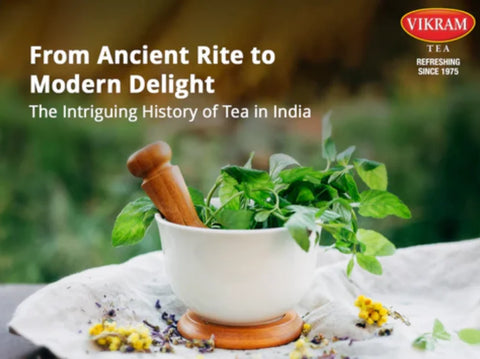Can you think of a day without tea? Sounds incomplete, doesn't it? Whether you're waking up to a refreshing cup of chai, taking a break with friends over a steaming brew, or enjoying a quiet evening with a fragrant blend, tea has become an inseparable part of daily life in India.
But how did this humble leaf, grown in the Himalayan foothills become a national obsession and a symbol of comfort for millions? Let's take a deep look into the insightful history of tea in India- its ancient roots, colonial influences, and how it emerged from being a medicinal drink to a modern-day delight.
The Origins: An Ancient Remedy
Long before tea became a global sensation, even before the British set foot on Indian soil, it was already a part of India’s ancient ritual. The natives of Assam who belonged to the northeastern region, brewed wild leaves, using it as a medicinal solution.
It was not the lovely chai we know today, but a herbal elixir meant for easy digestion, energy, and refreshment of the mind. Tea was essentially a tribal secret, known to no one else in India at that point in time. The first recorded human consumption of tea dates back to 2737 BC in China. In India's case, though, it was a totally different story. It’s believed that the people of Assam were boiling and drinking wild tea leaves long before tea took over the world stage. However, it remained hidden, a quiet practice, until the British “discovered” it much later.
The British Discovery: A Colonial Twist
Fast forward to the 19th century when India was under British rule. At that time, the British were importing tea from China, which became quite fashionable in Europe. However, the Chinese controlled the global tea trade and inflated the prices quite a lot. So the British East India Company sought a solution. What if India could produce its own tea?
In the 1820s, a Scottish adventurer by the name of Robert Bruce discovered wild tea plants growing robustly in Assam. This discovery was a revolution for tea in India. The British soon realized that Assam had a climate and soil that allowed for the mass cultivation of tea. Some years after testing, the first tea plantations were created there.
But the journey wasn’t smooth. Cultivating tea was labour-intensive, and the British needed workers. This is where things got darker—locals were coerced into working on tea plantations, often in harsh conditions. Despite this, India’s tea industry began to grow, and by the late 19th century, India was exporting tea globally, rivalling China’s monopoly.
Chai Revolution: From Eliteness to Everyday Life
Now you might be wondering, "Wait a minute, wasn't chai always part of Indian culture?" Not exactly. Tea in India was initially and primarily regarded as a colonial luxury drink of the British elite. It wasn't till the early 20th century that tea actually began spreading down to the masses.
How did it happen? The British-owned tea companies realized the vast potential of making Indians drink more tea at home. They introduced the "chai-wallah," vendors who sold tea at reasonable prices in small roadside stalls. The British used aggressive marketing tactics; they even made factory workers and office employees develop a habit of drinking tea during their breaks. Well, soon enough, and gradually, it became a drink for everyone but the elite.
What really made tea the iconic "chai" was the Indian flavour to it. Indians began using spices such as ginger, cardamom, and cinnamon to enhance the taste of the drink in addition to milk and sugar for preparing a rich, indulging taste. Chai is no longer merely a hot drink; it became a ritual with more emphasis on social gatherings and a symbol of warmth and hospitality.
The Modern Era: A Cup for Every Taste.
India produces, today, more than one-fourth of the tea leaves in the world. Chai is a staple in nearly every Indian household. Throughout the country, from the noisy railway stations to the quietness of homes, people are sipping tea. However, for India, tea is not all chai; with time, it has morphed into a product according to modern times.
Walk into any trendy café in India, and you’ll find an array of tea options—green tea, masala chai, Assam tea, Darjeeling tea, and even exotic herbal blends. Each region in India has its own tea speciality. Assam produces strong, bold teas that are perfect for chai, while Darjeeling, often referred to as the "Champagne of teas," offers a delicate and floral flavour that’s enjoyed without milk.
For example, in North India, it’s the Kashmiri kahwa, a fragrant saffron, cinnamon, and almond delight; while down South, it is filter chai, in which the brew that flows through a filter is repeated several times to make the tea thick, black, and deeply strong. But mainly, as in West Bengal and Assam, this beverage is either drunk straight black or with a dash of lemon.
Global Impact of Indian Tea
Not only did India adopt tea, but Indian tea has conquered the world. Each Indian tea brand, like Tata Tea, Brooke Bond, Nestea, Vikram Tea is known everywhere worldwide. India also exports a huge amount of tea to countries such as UK, US, and Russia.
Moreover, chai has crossed international borders and gained cult status in Western countries as well, especially in the form of “chai lattes.” Though these versions might be quite different from the traditional Indian chai, they symbolize the global reach of India’s tea culture.
The Future of Tea in India
India's tea industry looks forward to the future. Organic and speciality teas are gaining ground as health-conscious consumers look to try new flavours and experiences. Tea tourism is also on the rise in Assam, Darjeeling, and Kerala where travellers visit plantations to witness the traditional way of preparing tea themselves.
Yet, however, as much tea continues to evolve, one thing remains true: in India, it is not merely a cup of hot beverage. It’s a way of life interwoven between tea and Indian culture. Be it sharing a cup of tea with a complete stranger while sitting at some chai stall or expertly preparing the perfect brew at home, it brings people together across time, space and backgrounds.
So, the next time you sip on a cup of chai, remember—you’re part of a rich tradition that spans centuries. From ancient rituals to modern delights, the story of tea in India is indeed a tale of transformation, resilience, and, above all, the simple joy of enjoying a perfect cup.
What’s your favourite way to enjoy tea? Let’s talk chai!




